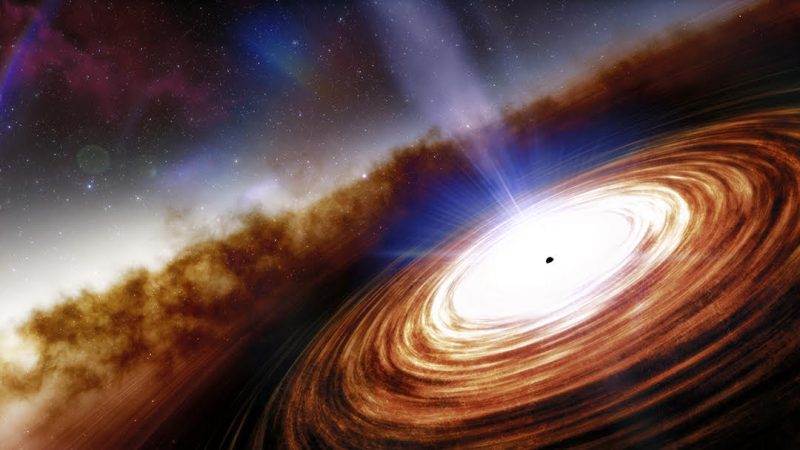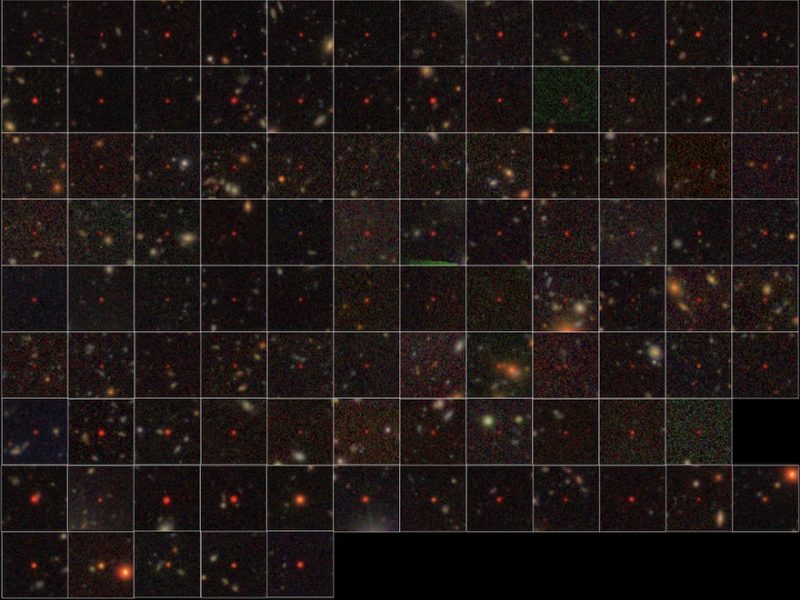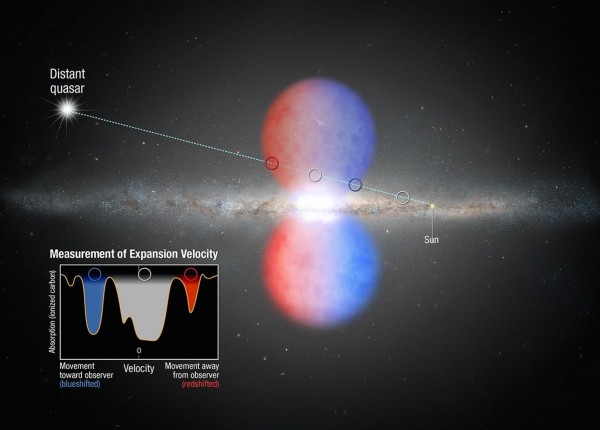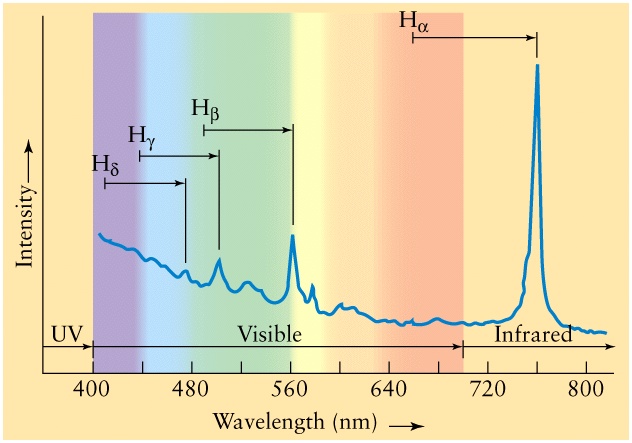

Artist’s concept of quasar J0313-1806, currently the most distant quasar known. Quasars are highly luminous objects in the early universe, thought to be powered by supermassive black holes. This illustration shows a wide accretion disk around a black hole, and depicts an extremely high-velocity wind, flowing at some 20% of light-speed, found in the vicinity of JO313-1806. View an annotated version of this image. Image via NOIRLab/ NSF/ AURA/ J. da Silva/ Keck Observatory.
The word quasar stands for quasi-stellar radio source. Quasars got that name because they looked starlike when astronomers first began to notice them in the late 1950s and early 60s. But quasars aren’t stars. They’re now known as young galaxies, located at vast distances from us, with their numbers increasing towards the edge of the visible universe. How can they be so far away and yet still visible? The answer is that quasars are extremely bright, up to 1,000 times brighter than our Milky Way galaxy. We know, therefore, that they’re highly active, emitting staggering amounts of radiation across the entire electromagnetic spectrum.
Because they’re far away, we’re seeing these objects as they were when our universe was young. The oldest quasar, currently, is J0313-1806. Its distance has been measured as 13.03 billion light-years, and therefore we see it as it was just 670 million years after the Big Bang.
What was happening in our universe at that time to make quasars so astoundingly bright?

Here are 100 quasars identified via data from the Hyper Suprime-Cam mounted on the Subaru Telescope. The top 7 rows represent the 83 new discoveries. The bottom 2 rows represent 17 previously known quasars in the survey area. Image via NAOJ.
Astronomers now believe that quasars are the extremely luminous centers of galaxies in their infancy. After decades of intense study, we have another term for these objects: a quasar is a type of active galactic nucleus, or AGN. There are actually many different types of AGNs, each with their own tale to tell. The intense radiation released by an AGN is thought to be powered by a supermassive black hole at its center. The radiation is emitted when material in the accretion disk surrounding the black hole is superheated to millions of degrees by the intense friction generated by the particles of dust, gas and other matter in the disk colliding countless times with each other.
The inward spiral of matter in a supermassive black hole’s accretion disk – that is, at the center of a quasar – is the result of particles colliding and bouncing against each other and losing momentum. That material came from the enormous clouds of gas, mainly consisting of molecular hydrogen, which filled the universe in the era shortly after the Big Bang.
Thus, positioned as they were in the early universe, quasars had a vast supply of matter to feed on.
As matter in a quasar/black hole’s accretion disk heats up, it generates radio waves, X-rays, ultraviolet and visible light. The quasar becomes so bright that it’s able to outshine entire galaxies. But remember … quasars are very far away. They’re so far from us that we only observe the active nucleus, or core, of the galaxy in which they reside. We see nothing of the galaxy apart from its bright center. It’s like seeing a distant car headlight at night: you have no idea of which type of car you are looking at, as everything apart from the headlight is in darkness.
On the other hand, there are galaxies which are not classed as quasars but that still have bright, active centers where we can see the rest of the galaxy. An example of this type of AGN is called a Seyfert galaxy after the late astronomer Carl Keenan Seyfert, who was the first to identify them.

NGC 1068 (Messier 77) was one of the first Seyfert galaxies classified. It’s the brightest and one of the closest and best-studied type 2 Seyfert galaxies, and is the prototype of this class. This 2013 image is via the Hubble Space Telescope.
Seyfert galaxies make up perhaps 10% of all the galaxies in the universe: they are not classed as quasars because they are much younger and have well-defined structures, rather than the rather formless and amorphous young galaxies which are presumed to have hosted quasars as soon as just a few hundred million years after the Big Bang.
But just consider the amounts of energy required to illuminate an object sufficiently to make it visible in radio waves from the farthest reaches of the universe, like a mariner being able to glimpse a distant lighthouse across an entire ocean. Quasars can emit up to a thousand times the energy of the combined luminosity of the 200 billion or so stars in our own Milky Way galaxy. A typical quasar is 27 trillion times brighter than our sun! Replace the sun in the sky with a quasar and its incredible luminosity would blind you instantly should you be foolhardy enough to look at it directly. If you were to place a quasar at the distance of Pluto, it would vaporize all of Earth’s oceans to steam in a fifth of a second.
Astronomers believe that most, if not all, large galaxies went through a so-called “quasar phase” in their youth, soon after their formation. If so, they subsided in brightness when they ran out of matter to feed the accretion disk surrounding their supermassive black holes. After this epoch, galaxies settled into quiescence, their central black holes starved of material to feed on. The black hole at the center of our own galaxy has been seen to flare up briefly, however, as passing material strays into it, releasing radio waves and X-rays. It’s conceivable that entire stars could be torn apart and consumed as they cross a black hole’s event horizon, the point of no return.
It must be pointed out, however, that our knowledge of galaxy evolution – from youthful quasar to quiescent middle-aged galaxy – is far from complete. Galaxies often provide us with exceptions, and as an example we need look no further than our own Milky Way. We now know, for example, that 3.5 million years ago there was a gigantic explosion known as a Seyfert flare at the center of our galaxy. It was apparently centered on Sagittarius A*, the Milky Way’s supermassive black hole, producing two huge lobes of superheated plasma extending some 25,000 light years from the north and south galactic poles. These huge lobes are called Fermi bubbles and are visible today at gamma and X-ray wavelengths (very high frequency electromagnetic emissions).
So astronomers are still learning about the specifics of galaxy evolution.

View larger. | Artist’s concept of the mind-boggling Fermi bubbles, discovered in 2010. These huge lobes extend above and below the plane of our Milky Way galaxy. They shine in gamma rays and X-rays and thus are invisible to the human eye. The graph shows how the Hubble Space Telescope was used to probe the light from a distant quasar to analyze the Fermi bubbles. A quasar’s light passed through one of these bubbles. Imprinted on that light is information about the outflow’s speed, composition, and eventually mass. Thus quasars aren’t only mysterious, they can be useful too! Image via HubbleSite.
Indeed, the history of quasars hasn’t been an easy road for astronomers to follow. When quasars were first discovered in the late 1950s, astronomers using radio telescopes saw starlike objects that radiated radio waves (hence quasi-stellar radio objects), but which were not visible in optical telescopes. Their resemblance to stars, their brightness and small angular diameters understandably led astronomers of the time to assume they were looking at objects within our own galaxy. However, examination of the radio spectra from these objects revealed them to be more mysterious than anyone had expected.
Many early observations of quasars, including those of 3C48 and 3C273, the first two quasars to be discovered, were made in the early 1960s by British-Australian astronomer John Bolton. He and his colleagues were puzzled by the fact that quasars were not visible in optical telescopes. They wanted to find quasars’ so-called “optical counterparts,” that is, a quasar which would be visible to their eyes in a telescope rather than only being detectable with radio instruments.
Astronomers simply didn’t know at that time that quasars were extremely distant, too distant for their optical counterparts to be visible from Earth at that time, despite being intrinsically brilliant objects. But then, in 1963, astronomers Allan Sandage and Thomas A. Matthews found what they were looking for: what appeared to be a faint, blue star at the location of a known quasar. Taking its spectrum, they were perplexed: it looked like nothing they had ever seen before. They couldn’t make heads or tails of it.
Then, using the 200-inch (5 m) Hale telescope, Bolton and his team were able to observe quasar 3C273 as it passed behind the moon. These observations also let them obtain spectra. And again the spectra looked strange, showing unrecognizable emission lines. These lines tell astronomers which chemical elements are present in the object they are examining. But the quasar’s spectral lines were nonsensical, seeming to indicate elements which should not be present.

The hydrogen spectrum of quasar 3C273. The emission lines are shifted to the right, toward longer wavelengths, compared to where hydrogen emission lines would normally be located on the spectrum. They are redshifted, indicating that the quasar is located at an extreme distance from us. Image via University of Alberta.
It was astronomer Maarten Schmidt who – after examining the strange emission lines in the spectra of quasars – suggested that astronomers were seeing normal emission lines that were highly shifted towards the red end of the electromagnetic spectrum!
And so they had their answer. The redshift was due to the quasar’s great distance. Its light is being stretched by the expansion of the universe during its long journey to us from the edge of the visible cosmos.
But if it were really true that quasars were as far away as towards the edge of the visible universe, how could they have generated such copious quantities of energy? Back in 1964, even the existence of black holes was hotly debated. There were many scientists who considered them nothing more than mathematical freaks, because surely they could not exist in the real universe.
So the debate about the nature of quasars raged on until the 1970s when a new generation of Earth- and space-based telescopes established beyond reasonable doubt that quasars do indeed lie at vast distances, that we are seeing galaxies when they were young, that the quasar stage is a natural phase of their growth. With black holes finally being taken seriously too, astronomers could now finally model the identity of the almost incomprehensible powerhouse behind quasars: supermassive black holes consuming stupendous amounts of gas and radiating vast amounts of energy across the spectrum as a result.
This model explains why quasars sit towards the edge of the visible universe and why we don’t see them closer: because quasars are young galaxies, seen not long after their formation in the early universe.
The study of quasars, and active galactic nuclei in general, has come far, but there is much we still don’t understand. However, I believe part of our lack of understanding is a failure of imagination. It is virtually impossible to comprehend the amounts of energy generated by the black hole engines at the hearts of quasars, those monsters in the dark. It is equally hard to appreciate just how far they are from us. But that is hardly our fault: our poor simian brains are just not well-equipped to deal with such concepts.
Quasars are just one example of an animal in the cosmic zoo about which one just has to accept the facts rather than try to comprehend them.

Artist’s concept of the quasar Poniua’ena, the first quasar to receive an indigenous Hawaiian name. Image via International Gemini Observatory/ NOIRLab/ NSF/ AURA/ P. Marenfeld/ UANews.
Bottom line: Quasars are extremely bright and extremely distant objects. Their huge energy output is thought to be due to activity around the central supermassive black hole in young galaxies, near the edge of the observable universe.
A few lunar calendars left. Order yours before they’re gone!
from EarthSky https://ift.tt/3qaJaPf


Artist’s concept of quasar J0313-1806, currently the most distant quasar known. Quasars are highly luminous objects in the early universe, thought to be powered by supermassive black holes. This illustration shows a wide accretion disk around a black hole, and depicts an extremely high-velocity wind, flowing at some 20% of light-speed, found in the vicinity of JO313-1806. View an annotated version of this image. Image via NOIRLab/ NSF/ AURA/ J. da Silva/ Keck Observatory.
The word quasar stands for quasi-stellar radio source. Quasars got that name because they looked starlike when astronomers first began to notice them in the late 1950s and early 60s. But quasars aren’t stars. They’re now known as young galaxies, located at vast distances from us, with their numbers increasing towards the edge of the visible universe. How can they be so far away and yet still visible? The answer is that quasars are extremely bright, up to 1,000 times brighter than our Milky Way galaxy. We know, therefore, that they’re highly active, emitting staggering amounts of radiation across the entire electromagnetic spectrum.
Because they’re far away, we’re seeing these objects as they were when our universe was young. The oldest quasar, currently, is J0313-1806. Its distance has been measured as 13.03 billion light-years, and therefore we see it as it was just 670 million years after the Big Bang.
What was happening in our universe at that time to make quasars so astoundingly bright?

Here are 100 quasars identified via data from the Hyper Suprime-Cam mounted on the Subaru Telescope. The top 7 rows represent the 83 new discoveries. The bottom 2 rows represent 17 previously known quasars in the survey area. Image via NAOJ.
Astronomers now believe that quasars are the extremely luminous centers of galaxies in their infancy. After decades of intense study, we have another term for these objects: a quasar is a type of active galactic nucleus, or AGN. There are actually many different types of AGNs, each with their own tale to tell. The intense radiation released by an AGN is thought to be powered by a supermassive black hole at its center. The radiation is emitted when material in the accretion disk surrounding the black hole is superheated to millions of degrees by the intense friction generated by the particles of dust, gas and other matter in the disk colliding countless times with each other.
The inward spiral of matter in a supermassive black hole’s accretion disk – that is, at the center of a quasar – is the result of particles colliding and bouncing against each other and losing momentum. That material came from the enormous clouds of gas, mainly consisting of molecular hydrogen, which filled the universe in the era shortly after the Big Bang.
Thus, positioned as they were in the early universe, quasars had a vast supply of matter to feed on.
As matter in a quasar/black hole’s accretion disk heats up, it generates radio waves, X-rays, ultraviolet and visible light. The quasar becomes so bright that it’s able to outshine entire galaxies. But remember … quasars are very far away. They’re so far from us that we only observe the active nucleus, or core, of the galaxy in which they reside. We see nothing of the galaxy apart from its bright center. It’s like seeing a distant car headlight at night: you have no idea of which type of car you are looking at, as everything apart from the headlight is in darkness.
On the other hand, there are galaxies which are not classed as quasars but that still have bright, active centers where we can see the rest of the galaxy. An example of this type of AGN is called a Seyfert galaxy after the late astronomer Carl Keenan Seyfert, who was the first to identify them.

NGC 1068 (Messier 77) was one of the first Seyfert galaxies classified. It’s the brightest and one of the closest and best-studied type 2 Seyfert galaxies, and is the prototype of this class. This 2013 image is via the Hubble Space Telescope.
Seyfert galaxies make up perhaps 10% of all the galaxies in the universe: they are not classed as quasars because they are much younger and have well-defined structures, rather than the rather formless and amorphous young galaxies which are presumed to have hosted quasars as soon as just a few hundred million years after the Big Bang.
But just consider the amounts of energy required to illuminate an object sufficiently to make it visible in radio waves from the farthest reaches of the universe, like a mariner being able to glimpse a distant lighthouse across an entire ocean. Quasars can emit up to a thousand times the energy of the combined luminosity of the 200 billion or so stars in our own Milky Way galaxy. A typical quasar is 27 trillion times brighter than our sun! Replace the sun in the sky with a quasar and its incredible luminosity would blind you instantly should you be foolhardy enough to look at it directly. If you were to place a quasar at the distance of Pluto, it would vaporize all of Earth’s oceans to steam in a fifth of a second.
Astronomers believe that most, if not all, large galaxies went through a so-called “quasar phase” in their youth, soon after their formation. If so, they subsided in brightness when they ran out of matter to feed the accretion disk surrounding their supermassive black holes. After this epoch, galaxies settled into quiescence, their central black holes starved of material to feed on. The black hole at the center of our own galaxy has been seen to flare up briefly, however, as passing material strays into it, releasing radio waves and X-rays. It’s conceivable that entire stars could be torn apart and consumed as they cross a black hole’s event horizon, the point of no return.
It must be pointed out, however, that our knowledge of galaxy evolution – from youthful quasar to quiescent middle-aged galaxy – is far from complete. Galaxies often provide us with exceptions, and as an example we need look no further than our own Milky Way. We now know, for example, that 3.5 million years ago there was a gigantic explosion known as a Seyfert flare at the center of our galaxy. It was apparently centered on Sagittarius A*, the Milky Way’s supermassive black hole, producing two huge lobes of superheated plasma extending some 25,000 light years from the north and south galactic poles. These huge lobes are called Fermi bubbles and are visible today at gamma and X-ray wavelengths (very high frequency electromagnetic emissions).
So astronomers are still learning about the specifics of galaxy evolution.

View larger. | Artist’s concept of the mind-boggling Fermi bubbles, discovered in 2010. These huge lobes extend above and below the plane of our Milky Way galaxy. They shine in gamma rays and X-rays and thus are invisible to the human eye. The graph shows how the Hubble Space Telescope was used to probe the light from a distant quasar to analyze the Fermi bubbles. A quasar’s light passed through one of these bubbles. Imprinted on that light is information about the outflow’s speed, composition, and eventually mass. Thus quasars aren’t only mysterious, they can be useful too! Image via HubbleSite.
Indeed, the history of quasars hasn’t been an easy road for astronomers to follow. When quasars were first discovered in the late 1950s, astronomers using radio telescopes saw starlike objects that radiated radio waves (hence quasi-stellar radio objects), but which were not visible in optical telescopes. Their resemblance to stars, their brightness and small angular diameters understandably led astronomers of the time to assume they were looking at objects within our own galaxy. However, examination of the radio spectra from these objects revealed them to be more mysterious than anyone had expected.
Many early observations of quasars, including those of 3C48 and 3C273, the first two quasars to be discovered, were made in the early 1960s by British-Australian astronomer John Bolton. He and his colleagues were puzzled by the fact that quasars were not visible in optical telescopes. They wanted to find quasars’ so-called “optical counterparts,” that is, a quasar which would be visible to their eyes in a telescope rather than only being detectable with radio instruments.
Astronomers simply didn’t know at that time that quasars were extremely distant, too distant for their optical counterparts to be visible from Earth at that time, despite being intrinsically brilliant objects. But then, in 1963, astronomers Allan Sandage and Thomas A. Matthews found what they were looking for: what appeared to be a faint, blue star at the location of a known quasar. Taking its spectrum, they were perplexed: it looked like nothing they had ever seen before. They couldn’t make heads or tails of it.
Then, using the 200-inch (5 m) Hale telescope, Bolton and his team were able to observe quasar 3C273 as it passed behind the moon. These observations also let them obtain spectra. And again the spectra looked strange, showing unrecognizable emission lines. These lines tell astronomers which chemical elements are present in the object they are examining. But the quasar’s spectral lines were nonsensical, seeming to indicate elements which should not be present.

The hydrogen spectrum of quasar 3C273. The emission lines are shifted to the right, toward longer wavelengths, compared to where hydrogen emission lines would normally be located on the spectrum. They are redshifted, indicating that the quasar is located at an extreme distance from us. Image via University of Alberta.
It was astronomer Maarten Schmidt who – after examining the strange emission lines in the spectra of quasars – suggested that astronomers were seeing normal emission lines that were highly shifted towards the red end of the electromagnetic spectrum!
And so they had their answer. The redshift was due to the quasar’s great distance. Its light is being stretched by the expansion of the universe during its long journey to us from the edge of the visible cosmos.
But if it were really true that quasars were as far away as towards the edge of the visible universe, how could they have generated such copious quantities of energy? Back in 1964, even the existence of black holes was hotly debated. There were many scientists who considered them nothing more than mathematical freaks, because surely they could not exist in the real universe.
So the debate about the nature of quasars raged on until the 1970s when a new generation of Earth- and space-based telescopes established beyond reasonable doubt that quasars do indeed lie at vast distances, that we are seeing galaxies when they were young, that the quasar stage is a natural phase of their growth. With black holes finally being taken seriously too, astronomers could now finally model the identity of the almost incomprehensible powerhouse behind quasars: supermassive black holes consuming stupendous amounts of gas and radiating vast amounts of energy across the spectrum as a result.
This model explains why quasars sit towards the edge of the visible universe and why we don’t see them closer: because quasars are young galaxies, seen not long after their formation in the early universe.
The study of quasars, and active galactic nuclei in general, has come far, but there is much we still don’t understand. However, I believe part of our lack of understanding is a failure of imagination. It is virtually impossible to comprehend the amounts of energy generated by the black hole engines at the hearts of quasars, those monsters in the dark. It is equally hard to appreciate just how far they are from us. But that is hardly our fault: our poor simian brains are just not well-equipped to deal with such concepts.
Quasars are just one example of an animal in the cosmic zoo about which one just has to accept the facts rather than try to comprehend them.

Artist’s concept of the quasar Poniua’ena, the first quasar to receive an indigenous Hawaiian name. Image via International Gemini Observatory/ NOIRLab/ NSF/ AURA/ P. Marenfeld/ UANews.
Bottom line: Quasars are extremely bright and extremely distant objects. Their huge energy output is thought to be due to activity around the central supermassive black hole in young galaxies, near the edge of the observable universe.
A few lunar calendars left. Order yours before they’re gone!
from EarthSky https://ift.tt/3qaJaPf

Aucun commentaire:
Enregistrer un commentaire